This article is about Price Elasticity of Demand (PED).
It defines, calculates and interprets Price Elasticity of Demand (PED) as well as explains the factors that determine Price Elasticity of Demand (PED) and its impact on company revenue. The graphs illustrate various stages of Price Elasticity of Demand (PED).
What is Price Elasticity of Demand (PED)?
Price Elasticity of Demand (PED) measures how a change in price affects quantity demanded. Simply, how much demand for a product decreases or increases following an increase or decrease in the price of that product.
How to calculate Price Elasticity of Demand (PED)?
Price Elasticity of Demand (PED) is calculated using the following equation:
| %∆ Change in Quantity Demanded | |
| Price Elasticity of Demand (PED) = | ━━━━━━━━━━━━━━━━━━━━━━━━━━━━━━━━━━━━━━ |
| %∆ Change in Price |
Where:
| Final Value – Original Value | ||
| %∆ Change = | ━━━━━━━━━━━━━━━━━━━━━━━━━━━━━━ | x 100 |
| Original Value |
NOTE: The final value of Price Elasticity of Demand (PED) is usually negative because of an inverse relationship between price and demand. When a price falls, this usually results in a rise in demand. Hence, it is common for marketers to ignore the negative sign of the Price Elasticity of Demand (PED) result. It is the extent of the change that is important here.
Different types of Price Elasticity of Demand (PED)
Price Elasticity of Demand (PED) is used to show the relationship that exists between the price of the product the demand for this product.
It measures the responsiveness of demand for a product after a change in price.
Price Elasticity of Demand (PED) can be either:
- Perfectly inelastic.
- Inelastic.
- Unit elastic.
- Elastic.
- Perfectly elastic.
The following descriptions of elasticities start from the situation when percentage change in price has completely no effect on quantity demanded until the situation when even a tiny change in price has a huge effect on quantity demanded.
1. Perfectly inelastic (PED = 0)
Value of Price Elasticity of Demand (PED) is 0. The product is to have perfectly inelastic demand. Demand does not react to change in price at all.
Comment: The percentage change in price of the product has no effect on the quantity demanded of that product. The same amount of product is demanded, no matter what the price is.
Examples of products: In reality, there are no products that would have this kind of Price Elasticity of Demand (PED). However, very rare or hard-to-find products such as rare art work, limited editions of comic books, first handwritten editions of famous books, life-saving medication for infants, etc. have Price Elasticity of Demand (PED) very close to 0.
How consumers behave? Consumers do not respond anyhow to a change in the price in this product.
Chart: The demand curve for perfectly inelastic products is vertical.
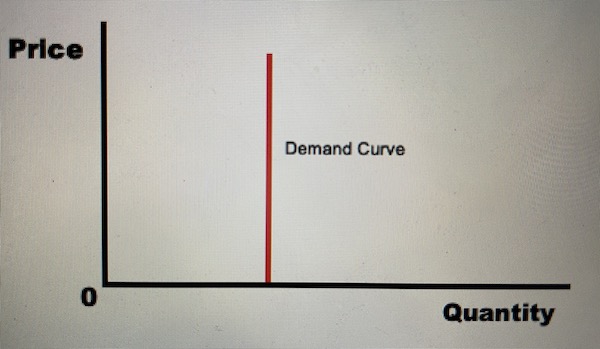
Calculations: The price of a product increased from USD$1,000,000 to USD$2,000,000 and demand did not change. What is the Price Elasticity of Demand (PED) for this product?
Step 1: Calculate the percentage change in Quantity Demanded.
%∆ Change in Quantity Demanded = 0%
Step 2: Calculate the percentage change in Price.
%∆ Change in Price = 100%
Step 3: Use the PED formula:
Price Elasticity of Demand (PED) = 0% / 100% = 0
It is now important to explain this result. A Price Elasticity of Demand (PED) of 0 means that demand changes by 0.0% for every 1.0% change in price.
What should the business do? If a firm faces this kind of elasticity of demand, it can raise the price indefinitely without losing any demand. This will increase the firm’s sales revenue. While a price reduction will reduce revenue because the demand will not change at all.
2. Inelastic (0 < PED < 1)
Value of Price Elasticity of Demand (PED) is higher than 0 but lower than 1. The product is to have relatively inelastic demand. Demand does not react strongly to change in price.
Comment: The percentage change in price of the product does not have strong effect on its demand. The percentage change in demand is less than the percentage change in price. The demand for inelastic goods and services is less responsive to price changes than others.
Examples of products: Products that are not very responsive to changes in their price have price inelastic demand. For example, bottled water, rice, potatoes, cooking oil, utilities, or any other product that customers need to buy to survive. This means that the percentage change in demand will be lower than the percentage change in price.
How consumers behave? Consumers do not respond greatly to a change in the price of the product. So, an increase in price will increase the firm’s revenue, while a decrease in price will decrease the firm’s revenue because demand will change very little.
Chart: The gradient of the demand curve for inelastic products is steep. The more inelastic the product is (PED closer to 0), the steeper the curve.
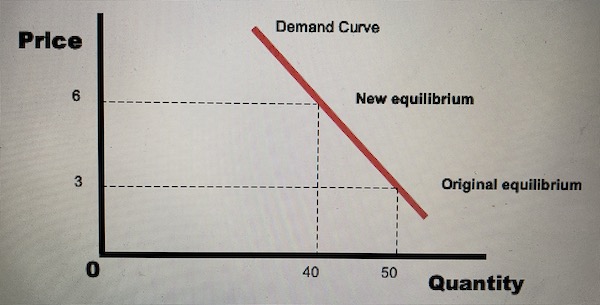
Calculations: The price of a product increased from USD$3 to USD$6 and demand changed from 50 units to 40 units. What is the Price Elasticity of Demand (PED) for this product?
Step 1: Calculate the percentage change in Quantity Demanded.
%∆ Change in Quantity Demanded = 20%
Step 2: Calculate the percentage change in Price.
%∆ Change in Price = 100%
Step 3: Use the PED formula:
Price Elasticity of Demand (PED) = 20% / 100% = 0.20
It is now important to explain this result. A Price Elasticity of Demand (PED) of 0.20 means that demand changes by 0.20% for every 1.0% change in price. The demand changes less than price.
What should the business do? If a firm faces this kind of elasticity of demand, it can increase the price without losing too many customers and much demand. Therefore, this will increase sales revenue because customers will buy only slightly less products but pay higher price for them. For example, assuming that the price elasticity of demand is 0.5, a 30% increase in price will lead to a 15% decrease in quantity demanded. But, increasing the price cannot continue indefinitely as the demand will start becoming more elastic. At some point, customers will start buying less when the price becomes too high.
3. Unit elastic (PED = 1)
Value of Price Elasticity of Demand (PED) is 1. The product is to have a unit elasticity or unitary elasticity.
Comment: The percentage change in price of the product is the same as the percentage change in demand for that product. The percentage change in demand is equal and opposite to the percentage change in price.
Examples of products: In reality, a unitary elastic product will maintain a certain level of income regardless of price. For instance, when the price is USD$1 then the demand will be 100 units, hence sales revenue will be USD$100. While when the price is USD$100 then the demand will be 1, hence sales revenue will also be USD$100.
How consumers behave? Any price change will lead to an equal change in demand and the total sales revenue will remain constant. Consumers respond proportionally to a change in the price in this product.
Chart: The demand curve for unit elastic products has a traditional demand curve shape.
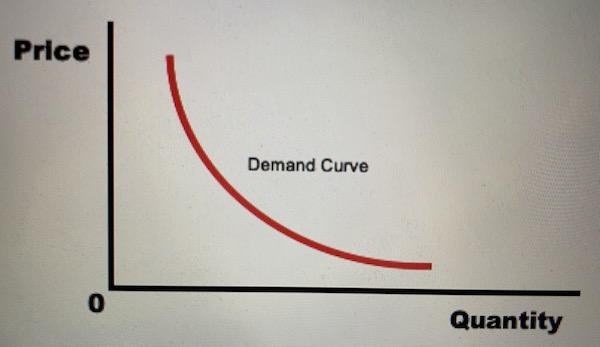
Calculations: The price of a product increased from USD$1,000 to USD$1,500 and demand for the product decreased from 2,000 to 1,000 units. What is the Price Elasticity of Demand (PED) for this product?
Step 1: Calculate the percentage change in Quantity Demanded.
%∆ Change in Quantity Demanded = 50%
Step 2: Calculate the percentage change in Price.
%∆ Change in Price = 50%
Step 3: Use the PED formula:
Price Elasticity of Demand (PED) = 50% / 50% = 1
It is now important to explain this result. A Price Elasticity of Demand (PED) of 1 means that demand changes by 1.0% for every 1.0% change in price. The demand changes the same as the price.
What should the business do? If a firm faces this kind of elasticity of demand, it can either increase the price or decrease the price without any impact on sales revenue. Demand will change proportionally in the opposite direction to the change in price, yet the sales revenue will remain the same. When the price increases, the demand will decrease. When the price decreases, the demand will increase. When the firm is facing problems with supply of products or not having enough inventory, it can temporarily increase the price. And when the firm is able to increase supply its products or has too much inventory, it can temporarily decrease the price.
4. Elastic (1 < PED < ∞)
Value of Price Elasticity of Demand (PED) is higher than 1. The product is to have relatively elastic demand. Demand reacts strongly to change in price.
Comment: The percentage change in price of the product has strong effect on its demand. The percentage change in demand is greater than the percentage change in price. The demand for elastic goods and services is more responsive to price changes than others.
Examples of products: Products that are more responsive to changes in their price have price elastic demand. For example, cinema tickets, ice-cream, soft drinks, coffee, snacks, holidays abroad, new furniture, or any other product that customers want to buy but do not need it to survive. This means that the percentage change in demand will be larger than the percentage change in price.
How consumers behave? Consumers respond greatly to a change in the price of the product. So, an increase in price will decrease the firm’s revenue, while a decrease in price will increase the firm’s revenue because demand will change a lot.
Chart: The gradient of the demand curve for elastic products is not steep. The more elastic the product is (PED having high number), the flatter the curve.
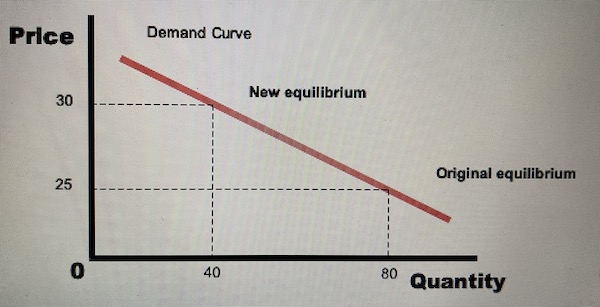
Calculations: The price of a product increased from USD$25 to USD$30 and demand changed from 80 units to 40 units. What is the Price Elasticity of Demand (PED) for this product?
Step 1: Calculate the percentage change in Quantity Demanded.
%∆ Change in Quantity Demanded = 50%
Step 2: Calculate the percentage change in Price.
%∆ Change in Price = 20%
Step 3: Use the PED formula:
Price Elasticity of Demand (PED) = 50% / 20% = 2.5
It is now important to explain this result. A Price Elasticity of Demand (PED) of 2.5 means that demand changes by 2.5% for every 1.0% change in price. The demand changes more than the price.
What should the business do? If a firm faces this kind of elasticity of demand, it can lower the price to pick up more customers and demand. Therefore, this will increase sales revenue because customers will buy more products when the price decreases. For example, assuming that the price elasticity of demand is 2, a 15% fall in price will lead to a 30% increase in quantity demanded.
5. Perfectly elastic (PED = ∞)
Value of Price Elasticity of Demand (PED) is infinite. The product is to have perfectly elastic demand. Demand does react even to a slight change in price – any change in price will see the quantity demanded fall to zero.
Comment: The percentage change in price of the product has extreme effect on the quantity demanded of that product. Buyers are prepared to buy all they need, but only for a limited price. An infinitely large amount is demanded at one price, but when the price is raised even by the smallest amount, then demand falls to zero.
Examples of products: In reality, there are no products that would have this kind of Price Elasticity of Demand (PED). It is because nobody will ever buy infinite number of products (any quantity) because nobody has infinite resources. Resources in the economy are always considered to be limited. However, public education and public healthcare have Price Elasticity of Demand (PED) very close to 1. If one public school decides to charge money for classes that are offered for free somewhere else, parents will transfer their children to the nearest school which offers free education. In the perfectly competitive market for gasoline there is an infinite number of producers and consumers in the market. There is no difference in the gasoline that is produced by the different producers. The demand curve for every producer will be perfectly elastic. If any gas station increases the price even by the smallest amount, the demand will disappear as customers will go to a different gas station.
How consumers behave? Consumers respond in an extreme way to even a slightest change in the price in this product.
Chart: The demand curve for perfectly inelastic products is horizontal.
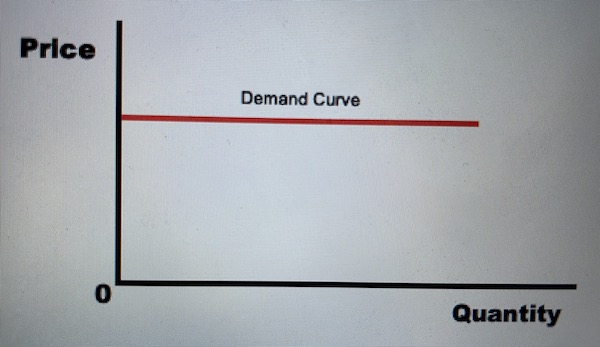
Calculations: The price of a product did not change, but demand increased from 10,000 to 20,000. What is the Price Elasticity of Demand (PED) for this product?
Step 1: Calculate the percentage change in Quantity Demanded.
%∆ Change in Quantity Demanded = 100%
Step 2: Calculate the percentage change in Price.
%∆ Change in Price = 0%
Step 3: Use the PED formula:
Price Elasticity of Demand (PED) = 100% / 0% = ∞
It is now important to explain this result. A Price Elasticity of Demand (PED) of ∞ means that demand is ∞ only at the certain price. Demand will drop to 0 for any change in price.
What should the business do? If a firm faces this kind of elasticity of demand, it cannot raise the price at all, otherwise it will lose all the demand. Keeping the same price and producing indefinite number of products will increase the firm’s sales revenue. While a price increase will reduce revenue to zero because the demand will change to zero.
Price Elasticity of Demand (PED) and Sales Revenue
Let’s see how to apply Price Elasticity of Demand (PED) into real business situations to help the business increase sales.
1. Helps with making pricing decisions. Price Elasticity of Demand (PED) is important when making price changes as it informs the managers whether total sales revenue will increase or decrease. In order to increases sales revenue and achieve the marketing objective of growth, the firm can do two things:
A. Increase the price (↑) for inelastic products. This will increase sales revenue. If managers decrease the price for inelastic products, the firm will experience a fall in total sales revenue.
B. Decrease the price (↓) for elastic products. This will increase sales revenue. If managers increase the price for elastic products, the firm will experience a fall in total sales revenue.
Let’s say a supermarket considers changing its pricing structure. Then, its management should be aware of Price Elasticity of Demand (PED) of different products. To boost sales revenue, the supermarket could increase prices of inelastic products and decrease prices of elastic products. Only when managers know the value of the price elasticity of demand for their products, then they can calculate the effect on sales of any proposed increase or decrease in price.
2. Helps with creating accurate sales forecasts. Price Elasticity of Demand (PED) is important when a business is preparing to update its prices and wishes to know predictions of sales revenue in the near future. In order to forecast the levels of future sales, business managers need to conduct specific calculations.
Let’s say a business sells one product costing USD$100. This product has had PED in the past few years around 0.5 and stable weekly sales of 10,000 units. Currently, weekly sales revenue amounts to USD$1,000,000. As this product is inelastic, the business should increase its price. When the firm increases the price by 10% as proposed by the marketing manager, then the demand will fall by 5%. The new weekly sales revenue will increase to USD$1,045,000 (new price of USD$110 x new demand of 9,500 units).
The determinants of Price Elasticity of Demand (PED)
There are many influences on Price Elasticity of Demand (PED):
1. Availability of substitutes. The greater the amount and quality of substitutes available, the more price elastic a good or service will be. Therefore, if there is a large number of substitutes, consumers will quickly switch to another brand, if the price of one manufacturer’s product increases. Hence, the more substitute products, the higher the elasticity. The less the amount and quality of substitutes available, the more price inelastic a good or service will be. Therefore, if there is a small number of substitutes, consumers will not be able to quickly switch to another brand, if the price of one manufacturer’s product increases. Hence, the fewer substitutes available, the less elastic the product is.
For example, wheat noodles can be replaced with noodles made by other producers, as well as noodles made from other raw materials such as rice, barley, bread, etc.
2. Necessities vs. Luxuries. Specifically, how necessary the product is. The more necessary consumers consider a product to be to their survival, the less they will react to price changes. This will tend to make the demand inelastic. The less necessary consumers consider a product to be to their survival, the more they will react to price changes. This will tend to make the demand elastic.
For example, almost all of the basic products that fulfill human basic needs will have inelastic demand such as food, water, shelter, clothes, warmth sources in the household.
3. Time. The more time passes, the more likely it is that there will be new substitutes or people will able to use a product more efficiently. When the product is not needed urgently, customers will be more price conscious as they can make comparisons, or find a different way to fulfill their needs and wants. Generally, the longer the time, the greater the elasticity. The less time passes, the less likely it is that there will be new substitutes nor people will able to use a product more efficiently. When the product is needed urgently, customers will not be very price conscious – they will most likely pay any price to fulfill their needs and wants. Generally, the shorter the time, the lower the elasticity.
For example, coal for heating homes has become more price elastic as people have found new ways of heating their homes such as using natural gas, electricity, as well as renewable energy sources like solar and wind.
4. Percentage of income spent on the item. Specifically, the price of the product as a proportion of consumers’ incomes. Cheaper products that account for relatively small percentage of consumer income tend to be inelastic since high percentage price changes still result in a cheap product. More expensive products that account for relatively higher percentage of consumer income tend to be elastic since low percentage price changes still result in an expensive product.
For example, batteries or matches are likely to care too much about a 10% or 15% price increase because the product is cheap enough and customers buy it maybe once every couple of months.
5. Customer loyalty. Those firms which have successfully branded their products to create a high degree of following and loyalty among consumers, are likely to have their products purchased following a price rise. Hence, their product will be inelastic. Those firms which do not have a high degree of following and loyalty among consumers, are not likely to have their products purchased following a price rise. Hence, their product will be inelastic.
For example, producers such as Coca-Cola which has influential advertising and promotional campaigns to make their products more distinct, has very loyal customers. People want to feel different, people want to feel happy when drinking Coke.
6. Addictions. Demand for addictive products such as cigarettes and other tobacco products will be price inelastic. It is because many smokers feel that they ‘need’ to smoke to cope with their lives and will not reduce demand even as the price of cigarettes increases significantly. The more addictive the product is, the more inelastic its demand tend to be as users will pay ‘any price’ just to get it.
For example, many companies these days try to make their customers addicted to their products such as bars and restaurants, computer games, soft drinks, chocolate, etc. in order to lower the elasticity, hence future price increases will be possible without losing much demand.
7. Government regulations. If there are many competitors on the market because the market is not highly regulated, then there are a large number of businesses. And consumers will quickly switch to another brand, if the price of one manufacturer’s product increases. Hence, the more competition, the higher the elasticity. If there are fewer competitors on the market because the market is highly regulated, then there are a small number of businesses. And consumers will not be able to quickly switch to another brand, if the price of one manufacturer’s product increases. Hence, the less competition, the less elastic the product is.
For example, utilities providers such as water, gas and electricity are highly regulated by the government. The number of companies being allowed in the market is very limited and the barriers to entry are especially high.
Drawbacks of Price Elasticity of Demand (PED)
Price Elasticity of Demand (PED) has many uses when it comes to sales revenue, but there are also limitations:
- May be based on inaccurate data. It is not always easy, or indeed possible, to calculate PED. The data needed for working it out PED include historical changes in the price of the product and historical changes in the demand for that product. It is not always easy to get the exact numbers for past sales results following previous price changes. And, when it comes to new products just entering into the market, the data will just be estimations trying to identify the quantities that potential customers would purchase at different price levels.
- Assumes that everything else except the price and demand remained constant. Assuming that nothing changed but the price of the product and the demand for that product is a mistake. Expected sales of the product might increase sharply not because the firm lowered the price, but because two competitors went bankrupt, for example. There are just so many more factors that can impact the demand, not only just the price
- May become outdated quickly. PED calculations will become outdated quickly because markets change all the time, every day. Every time the company changes prices of its products, PEDs will need to be recalculated. Also, as market conditions change constantly, different year’s PED calculation may be very different making them impossible to draw reasonable conclusions.
Summary
Price Elasticity of Demand (PED) looks at how change in the price of the product affects the demand for this product.
It is important as customers of different products react to changes in price differently. Elastic demand means that the response to a price change is great. Inelastic demand means the response to a price change is small.
Understanding elasticity can help businesses to effectively plan price strategies and anticipate how changes in the economy and various markets will affect the demand for their products.
 Articles: 1,557 · Readers: 757,000 · Views: 2,260,160
Articles: 1,557 · Readers: 757,000 · Views: 2,260,160 